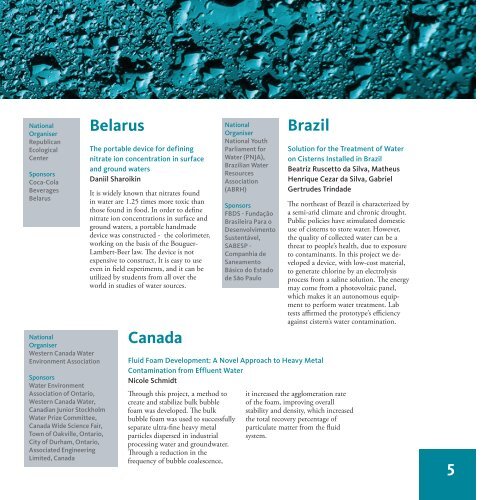2017 Stockholm Junior Water Prize Finalists
Each year, the Stockholm Junior Water Prize congregates young scientists and innovators from around the world who have created new solutions to the planet’s growing water challenges. Each of the finalists represented in Stockholm are the champions of their national competition and have been selected as winners from thousands of entries for their outstanding work.
Each year, the Stockholm Junior Water Prize congregates young scientists and innovators from around the world who have created new
solutions to the planet’s growing water challenges. Each of the finalists represented in Stockholm are the champions of their national
competition and have been selected as winners from thousands of entries for their outstanding work.
Create successful ePaper yourself
Turn your PDF publications into a flip-book with our unique Google optimized e-Paper software.
National<br />
Organiser<br />
Republican<br />
Ecological<br />
Center<br />
Sponsors<br />
Coca-Cola<br />
Beverages<br />
Belarus<br />
National<br />
Organiser<br />
Western Canada <strong>Water</strong><br />
Environment Association<br />
Sponsors<br />
<strong>Water</strong> Environment<br />
Association of Ontario,<br />
Western Canada <strong>Water</strong>,<br />
Canadian <strong>Junior</strong> <strong>Stockholm</strong><br />
<strong>Water</strong> <strong>Prize</strong> Committee,<br />
Canada Wide Science Fair,<br />
Town of Oakville, Ontario,<br />
City of Durham, Ontario,<br />
Associated Engineering<br />
Limited, Canada<br />
Belarus<br />
The portable device for defining<br />
nitrate ion concentration in surface<br />
and ground waters<br />
Daniil Sharoikin<br />
It is widely known that nitrates found<br />
in water are 1.25 times more toxic than<br />
those found in food. In order to define<br />
nitrate ion concentrations in surface and<br />
ground waters, a portable handmade<br />
device was constructed - the colorimeter,<br />
working on the basis of the Bouguer-<br />
Lambert-Beer law. The device is not<br />
expensive to construct, It is easy to use<br />
even in field experiments, and it can be<br />
utilized by students from all over the<br />
world in studies of water sources.<br />
Canada<br />
Fluid Foam Development: A Novel Approach to Heavy Metal<br />
Contamination from Effluent <strong>Water</strong><br />
Nicole Schmidt<br />
Through this project, a method to<br />
create and stabilize bulk bubble<br />
foam was developed. The bulk<br />
bubble foam was used to successfully<br />
separate ultra-fine heavy metal<br />
particles dispersed in industrial<br />
processing water and groundwater.<br />
Through a reduction in the<br />
frequency of bubble coalescence,<br />
National<br />
Organiser<br />
National Youth<br />
Parliament for<br />
<strong>Water</strong> (PNJA),<br />
Brazilian <strong>Water</strong><br />
Resources<br />
Association<br />
(ABRH)<br />
Sponsors<br />
FBDS - Fundação<br />
Brasileira Para o<br />
Desenvolvimento<br />
Sustentável,<br />
SABESP -<br />
Companhia de<br />
Saneamento<br />
Básico do Estado<br />
de São Paulo<br />
Brazil<br />
Solution for the Treatment of <strong>Water</strong><br />
on Cisterns Installed in Brazil<br />
Beatriz Ruscetto da Silva, Matheus<br />
Henrique Cezar da Silva, Gabriel<br />
Gertrudes Trindade<br />
The northeast of Brazil is characterized by<br />
a semi-arid climate and chronic drought.<br />
Public policies have stimulated domestic<br />
use of cisterns to store water. However,<br />
the quality of collected water can be a<br />
threat to people’s health, due to exposure<br />
to contaminants. In this project we developed<br />
a device, with low-cost material,<br />
to generate chlorine by an electrolysis<br />
process from a saline solution. The energy<br />
may come from a photovoltaic panel,<br />
which makes it an autonomous equipment<br />
to perform water treatment. Lab<br />
tests affirmed the prototype’s efficiency<br />
against cistern’s water contamination.<br />
it increased the agglomeration rate<br />
of the foam, improving overall<br />
stability and density, which increased<br />
the total recovery percentage of<br />
particulate matter from the fluid<br />
system.<br />
5


















